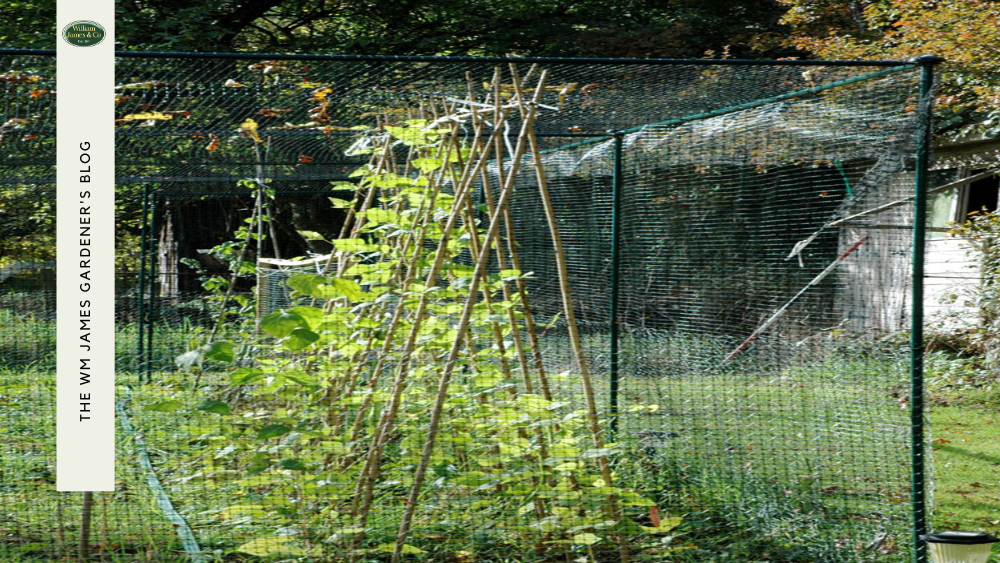We use cookies to make your experience better. To comply with the new e-Privacy directive, we need to ask for your consent to set the cookies. Learn more.
How to Get Rid of Patio Weeds: Easy DIY Solutions
- Admin
- WM James Gardening Blog
- 27 Jan 2025
-
258views

If you love sitting out on your patio but get distracted by ugly weeds every time, this is your sign to address the problem once and for all. We're going to tell you exactly how to get rid of patio weeds without damaging your landscape along the way.
In This Guide:
5 DIY Methods for Killing Weeds Organically
Manually Removing Weeds from Pavers
How to Stop Weeds in Block Paving
Managing Patio Weeds Throughout the Year
Many gardeners use herbicides to kill their weeds, but actually, this should be the last thing you reach for. Herbicides can do more damage than good to your garden and the environment, which is why we only suggest organic ways of removing weeds.
In this guide, we’re going to share some of the best – and easiest – ways to get rid of weeds in your garden, so you can enjoy a beautiful, weed-free patio all year round.
If you want to be one step ahead of our guide, add some of our weed control and removal products to your basket now! Free delivery is available*.
The Problem With Patio Weeds
Avid gardeners will already know the disadvantages that weeds bring to any outdoor space, but if you're just dipping your toes into the world of gardening, it'll be good for you to understand their impact and why it's essential to address them.
So, without further ado, here is the full list of why gardeners can't stand weeds:
- Aesthetic impact – Weeds disrupt the polished look of patios.
- Structural damage – Weeds can be quite forceful and make their way through paving slabs, widening their cracks over time. They can also lift patios over time, causing an uneven surface.
- Safety concerns – Overgrown weeds can create slippery surfaces when wet and hide sharp objects.
- Encouragement of garden pests – Weeds provide shelter for insects and rodents, which bring their own set of problems.
- Competition with wanted plants – In nearby garden beds, patio weeds can compete with cultivated plants, draining their nutrient supply.
- Time and maintenance concerns – Constantly removing patio weeds can be time-consuming, as they can grow back very quickly if not dealt with permanently!
- Environmental concerns – Many people use chemical herbicides, which can harm the environment and surrounding plants. It's best to avoid these where possible.
5 DIY Methods for Killing Weeds Organically
Killing weeds organically is the recommended option over using chemical herbicides to remove weeds.
Chemical herbicides are toxic and can damage gardeners, pets, and the surrounding landscape. They are also less cost-effective, as they’re a short-term option.
Hence why natural weed killer methods are preferred over their unnatural counterparts.
Let's get into our recommendations.
Read More DIY Gardening Recommendations
#1 Baking Soda
Baking soda for killing weeds is a popular method due to it being highly alkaline and its high salt content, making it effective at dehydrating and killing weeds.
Simply sprinkle over the area of weeds you want to remove, and spray a little water on top to help the baking soda adhere to the plants.
This works great for small areas of plants and, therefore, great for patio gaps and cracks.
Top tip: As with all these methods, you should remove the dead weeds to avoid regrowth of any kind. Leave them for a few days to fully wilt and brown off, and then remove them manually with a hand fork or patio cleaning brush.
Tools we recommend:
#2 Boiling Water
Boiling water destroys weeds' cell structures by causing thermal shock. For larger weeds, it may require a few applications, but this is definitely a cheap and effective method.
All you need to do is boil your kettle and slowly pour the piping hot water (be careful here, you don't want to catch a nasty burn) directly on the weeds, focusing on the base of the weed.
It's best to do this in dry weather to ensure the boiling water isn't cooled by rain or moisture.
#3 Saltwater
Saltwater works the same as bicarbonate of soda, where it dehydrates and ultimately kills the weeds.
You only need to mix one part salt with two parts hot water and pour the solution on the weeds, focusing on the base of the plant.
#4 Vinegar
Once again, vinegar is another household item you can use to dehydrate and kill your weeds. Household vinegar contains 5% acetic acid, but horticultural vinegar contains 20-30%, so this is more effective but much worse for the environment.
If you choose to use horticultural vinegar, take caution, as it’s much stronger.
Simply fill a spray bottle with your choice of vinegar, and spray your weeds with precision, focusing on the base.
It's best to apply this on a hot sunny day, because it'll enhance the effectiveness.
#5 Mulch
Lastly, organic mulch can be very effective at killing young weeds, acting as a barrier that cuts off sunlight and air that weeds need to grow.
Simply remove any existing weeds using a patio brush, or pull them out with your hands, and spread an even layer of 2-3 inches of mulch over the areas where weeds are likely to grow using a hand trowel.
You'll probably need to keep adding mulch as time passes because it can naturally compress or decompose.
Our most popular hand trowels:
Manually Removing Weeds from Pavers
Physically removing weeds is another effective method of killing weeds and stopping regrowth without homemade solutions.
Our ergonomic Wooden Paving & Patio Cleaning Brush would be the perfect tool for this job. It's super simple to use and has an extra-long wooden handle to reduce strain on your knees, back, and joints.
All you need to do is angle the brush inside the gaps of your patio, where the weeds are growing, and apply firm pressure while scrubbing the brush along the length of the gap.
To kill the weed fully, focus on removing both the leaves and the root system.
Once all debris is loose, you can manually pick it up (while wearing gloves, of course) and dispose of it in a bin bag to prevent the weeds from spreading.
Top tip: Weeds are more easily extracted when the soil is wet, so wait for a rainy day or water the gaps with a watering can yourself.
How to Stop Weeds in Block Paving
Once you've removed everything from the gap, you need a way to stop any weed regrowth, so what do you do?
To prevent the weeds from returning, you could fill the gap with sand, sealant, or some weed control fabric. This will stop weeds from growing, keeping your patio gaps fresh and pristine.
Our Heavy-Duty Weed Control Fabric blocks light to stunt weed growth, making it the ideal solution for natural weed killing.
It’s made from high-quality polypropylene and is UV-stabilised against the damage of sunlight, providing prolonged use.
For more products to help tackle your weed problem, head to our weed control section!
Discover More of Our Garden Fabrics
Managing Patio Weeds Throughout the Year
Now that you've removed your weeds, it's a good idea to take preventative measures, such as pest and insect control, so they don't pop up again and surprise you.
As with all garden plants, weed growth varies from season to season, so each comes with a different set of requirements. Here are our recommendations:
| Season | How to Prevent Patio Weeds |
| Spring |
|
| Summer |
|
| Autumn |
|
| Winter |
|
Final Thoughts: Banishing Weeds For a Happy, Healthy Garden
And there you have it! Plenty of methods you can use in your garden to get rid of those pesky weeds for good!
No gardener wants weeds like thistles and nettles to take over the beauty of an outdoor space, especially when they work so hard to keep it looking picturesque.
So, try out one of our recommended methods today and see which one works best for you. Hopefully, soon, you can enjoy a relaxing, weed-free patio space!
Check out our must-have products to help prevent and remove weeds below!
For any more help or advice on weed removal and control, please don't hesitate to contact us! With over 60 years in the horticultural industry, we know a thing or two about the bothersome plants!
*Free delivery is available on orders over £100.
FAQs
What Kills Patio Weeds Permanently?
There are various ways to kill weeds for good, one of which is vinegar. Vinegar's acidity will dry out the plant, causing it to die in 24 hours.
You need to be careful using vinegar, though, as it can damage nearby plants you don't want to kill.
For more ways you can kill patio weeds, check out our post above!
What is the Easiest Way to Remove Weeds from a Patio?
There are plenty of ways to easily remove weeds from a patio, even using everyday household items. Some of these methods include pouring boiling water over the weeds and manually removing them with a patio brush.
Do You Have Any Weed Control Products I Can Buy?
We do! Here at WM James, we have Heavy-Duty Weed Control Ground Covers as preventative measures. We also have a Wooden Paving and Patio Cleaning Brush with Wire Bristles to help you reach the small gaps in your patio.
How Do I Stop Weeds from Growing Between Patio Slabs?
To prevent weeds from growing between your patio slabs, you could lay weed barrier fabric underneath your patio or use sand, which stunts growth.











